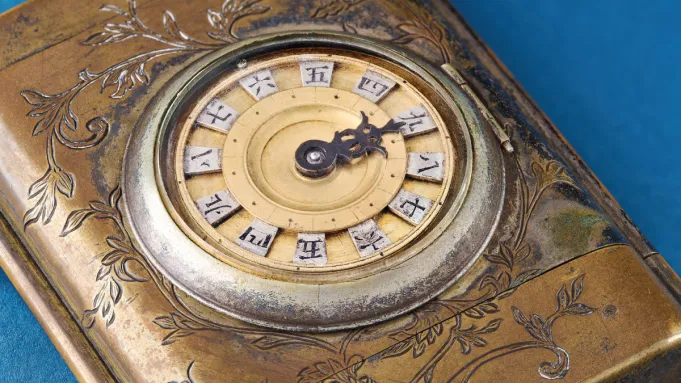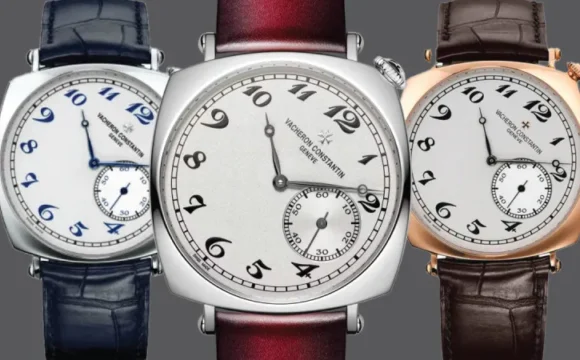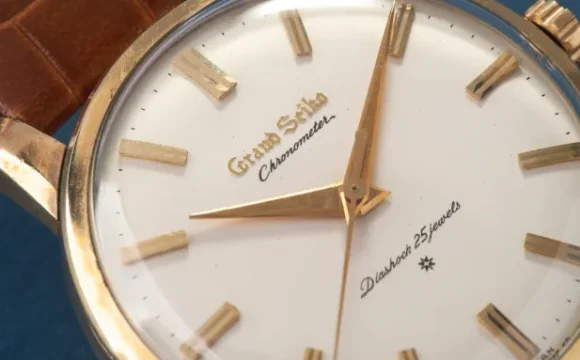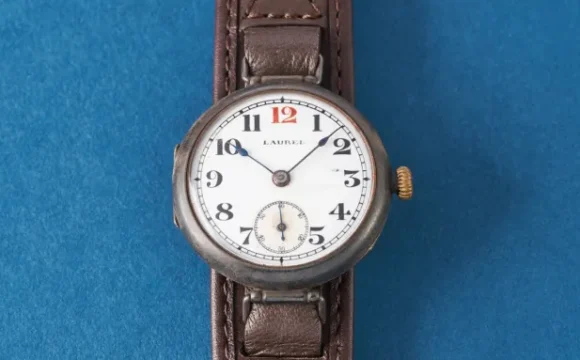นิทรรศการเริ่มต้นด้วย Wadokei Inro หรือนาฬิกาพกญี่ปุ่นสองเรือนจากศตวรรษที่ 19 นาฬิกา Wadokei นั้นน่าสนใจเพราะถูกสร้างขึ้นเพื่อแสดงเวลาแบบญี่ปุ่นดั้งเดิม เวลาแบบญี่ปุ่นดั้งเดิมหรือเวลาตามฤดูกาลแบ่งแต่ละวันออกเป็นสองชุดเวลาเท่ากันหกชั่วโมง ชุดหนึ่งสำหรับกลางวันระหว่างพระอาทิตย์ขึ้นและพระอาทิตย์ตก และอีกชุดหนึ่งสำหรับเวลากลางคืนตั้งแต่พระอาทิตย์ตกถึงพระอาทิตย์ขึ้น เนื่องจากพระอาทิตย์ขึ้นและพระอาทิตย์ตกเปลี่ยนแปลงไปทุกวันตามฤดูกาล ความยาวของแต่ละชั่วโมงกลางวันและกลางคืนจึงไม่เท่ากันและเปลี่ยนแปลงทุกวันด้วย
มันเหมือนกับชั่วโมงปกติสมัยใหม่ของเราที่จะมีจำนวนนาทีที่แตกต่างกันในระหว่างวันเมื่อเทียบกับตอนกลางคืน และชั่วโมงจะเปลี่ยนไปในวันถัดไปและวันถัดไป บางครั้งชั่วโมงกลางวันอาจสั้นกว่าชั่วโมงกลางคืน และบางครั้งอาจยาวกว่า
เพื่อคำนึงถึงการเปลี่ยนแปลงของเวลาตามฤดูกาลในนาฬิกา ซึ่งเป็นกลไกที่ออกแบบให้เดินด้วยอัตราเดียวกันทุกวันโดยใช้อัตราส่วนเกียร์คงที่ ตัวเลขบนหน้าปัดกลมจะต้องเคลื่อนที่ ใกล้กันเล็กน้อยหรือห่างกันเล็กน้อยทุกวันและทุกคืน สังเกตใต้กระจกของนาฬิกาและคุณจะเห็นร่องที่ตัวเลขเคลื่อนที่ภายในเพื่อคงความยาวที่เปลี่ยนแปลงของชั่วโมง
นาฬิกา Wadokei มีบทบาทสำคัญในประวัติศาสตร์ของ Seiko เวลาตามฤดูกาลหมดความนิยมในญี่ปุ่นเมื่อเริ่มต้นยุคเมจิที่มีความก้าวหน้าทางเทคโนโลยีมีมากขึ้นในปี 1868 และถูกยกเลิกอย่างเป็นทางการในปี 1872 ด้วยการยอมรับเวลาตะวันตกและปฏิทินเกรกอเรียน Kintaro Hattori ก่อตั้ง K. Hattori & Co. (ปัจจุบันคือ Seiko Corporation) ในปี 1881 เพื่อขายและซ่อมนาฬิกาตะวันตกที่นำเข้ามาใหม่ หากไม่มีการเปลี่ยนแปลงจากนาฬิกา Wadokei นาฬิกา Seiko หรือ Grand Seiko ที่เรารู้จักในปัจจุบันอาจไม่มีอยู่ก็ได้
จากบทความโดย David Flett
The exhibition starts with two Wadokei Inro or Japanese pocket watches from the 19th century. Wadokei timepeices are fascinating because they were made to display traditional Japanese time. Traditional Japanese, or seasonal time, divides each day into two sets of six equal hours. One set of hours is for the day, between sunrise and sunset and the other is for the night hours from sunset to sunrise. Since sunrise and sunset vary daily as the seasons progress, the length of each day-hour and night-hour are not the same and they also change every day!
It’s as if our modern, regular hours would be a different number of minutes during the day, compared to the night, and the hours would change the next day and the next day. Sometimes a day-hour might be shorter than a night-hour, and sometimes it might be longer.
To account for such seasonal time variations in a clock—a mechanism that by design ticks at the same rate every day using fixed gear ratios—the numerals on a circular dial must move. A little closer together or a little further apart each day and each night. Look closely beneath the glass of the timepieces and you can see the indented tracks the numerals move within to account for the changing length of the hours.
The Wadokei clocks play a fundamental part in Seiko’s history. Seasonal time fell out of favor in Japan at the beginning of the more technologically ambitious Meiji period in 1868 and was completely abandoned by 1872 with the adoption of Western time and the Gregorian calendar. Kintaro Hattori established K. Hattori & Co. (now the Seiko Corporation) in 1881 to sell and repair the newly imported Western clocks and watches. Without the move away from Wadokei clocks, the Seiko or Grand Seiko that we know today may not have existed.
From the article by David Flett








